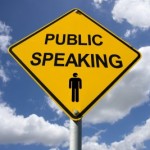Public Speaking Fears: How to Move through them
Moving through Public Speaking Fears: Testing it
 There are two components to moving through fear. One component consists of actually creating your own test for the fear. The subsequent component involves preparing for the test. Think about that. Most of us have taken tests both when we were prepared and when we weren’t prepared. What is the common thought and feeling before and after having taken a test for which we weren’t prepared? “I should’ve studied.” We feel anxious and even guilty. You can “study” for your own self-crafted public speaking test. Creating your test, preparing for it, and taking it pushes you beyond your comfort zone. It empowers you.
There are two components to moving through fear. One component consists of actually creating your own test for the fear. The subsequent component involves preparing for the test. Think about that. Most of us have taken tests both when we were prepared and when we weren’t prepared. What is the common thought and feeling before and after having taken a test for which we weren’t prepared? “I should’ve studied.” We feel anxious and even guilty. You can “study” for your own self-crafted public speaking test. Creating your test, preparing for it, and taking it pushes you beyond your comfort zone. It empowers you.
Step One: Increasing Awareness
Beware that you can actually manifest the very things you fear if you lack awareness. You will diminish or even prevent the likelihood of manifesting your fears if you increase your awareness. To do this, begin to look at what it is that you fear.
What is your greatest fear of public speaking? Here are 3 fears many people experience:
- People won’t like what I have to say
- I’ll look dumb
- I will forget what I want to say
Do you have any of those thoughts? If so, it’s time to find the evidence either for or against those fears. It’s time to design your own fear test.
Step Two: Designing your Fear Test
In order to break through your own fear of public speaking, it’s imperative to test your fears. Set up a test. Choose a situation that you fear will cause the very outcomes you are trying to avoid. Each scenario is different for each of us. If you’re new to public speaking, your test design might consist of going to a networking meeting and delivering your “elevator speech” for a minute. If you’re at a an intermediate level, you might want to book a presentation with a non-profit group who would be interested in your work. If you’re at and advanced level, your test might be best designed to speak in-person or via a webcast to showcase your expertise, either offering your presentation free, or at a charge.
Step 3: Preparing
Catchy Intro
Now that you’ve set up your test, it’s time to practice, practice, practice! There are many tools available for preparing for a presentation. First determine why the information you have to share is important to your audience. Think about how it will change some aspect of their lives. Craft a catchy start to your presentation to engage your audience immediately. It may be a relevant personal anecdote, a joke (if this suits your personality), engaging questions related to then content of your speech, or a scenario in which they may have found themselves that relates to the information you’ll be sharing with them.
Outline
After you’ve designed the introduction to your presentation, start out with notes, making an outline of your topic(s). If you’re an auditory-verbal learner, dictate your information into a voice-activated program, such as the free application on phones. The automatic dictation will save you time writing/typing. Transition the information smoothly from one topic to another. Design the end of your presentation including a brief summary of the importance of the topic(s) to the lives of the audience members and call them to action.
Speech and Posture
Throughout your presentation, use a conversational tone, varying your pitch. Make eye contact with one person at a time rather than gazing out at the audience in general. Rise up out of your hips. This will automatically lift your torso upward. With your chest up, your lungs will have room to fill. Use a loud enough voice. Speaking from your diaphragm will allow your voice to sound natural rather than forced. Relax your knees, belly, and shoulders when standing.
Rehearsing for Comfort
If you are giving your speech in person, chunking large pieces of information will help you remember it without having to use notes. Use acronyms, verbal, or visual association. Verbally rehearse your speech. Practice your presentation aloud until you feel comfortable, are free of unexpected pauses, and sound natural and interesting to listen to. Preparing will allow you to leave room for ad-libbing and will free you up to have fun!

Another great post, Cher! ~ I love how you invite us into finding our own evidence to justify the fears we have – through an actual “test” rather than what we “think” might happen. ~ This makes it much more real – and gives us an experience we can draw upon. ~ I think we’re always more afraid of what’s unknown – than the actual reality. Once we can get an experience under our belt, it all goes uphill from there! 🙂
Well-thought out ideas, Cher! Much appreciated!!
A great article Cher. Public speaking is something we all need to learn more about.
Great article Cher! I really have to work on this, I’m very shy and get super nervous. Will start by a networking meeting in a few weeks and then in May I have my 1st workshop, so I need to work on this. Thanks for sharing 🙂
Cher – I am scheduled to give my Ice Breaker Speech in a few weeks at my Toast Masters meeting. I am both excited and scarred. I have all three of the fears you mentioned. I know as I sit down and prepare my fear will start to loosen it’s grip and my excitement will infuse me. The key will be maintaining this poise as I step up that morning to deliver. I will re-read this post and use it as a valuable resource to test my fears and move more into the full expression of Authentic Self. Thank you for sharing your wisdom!